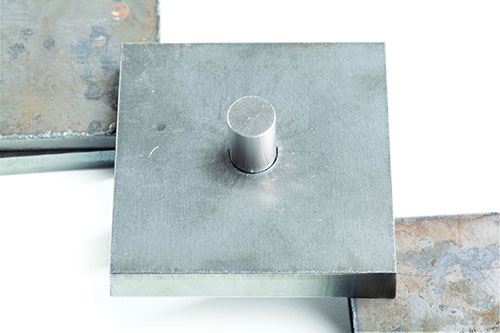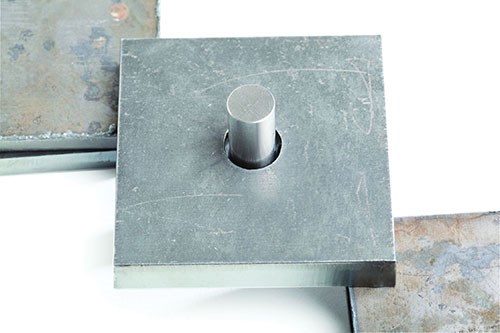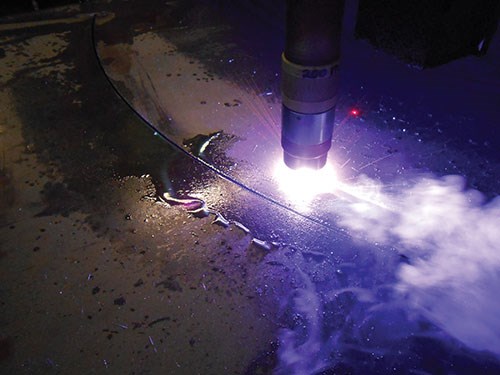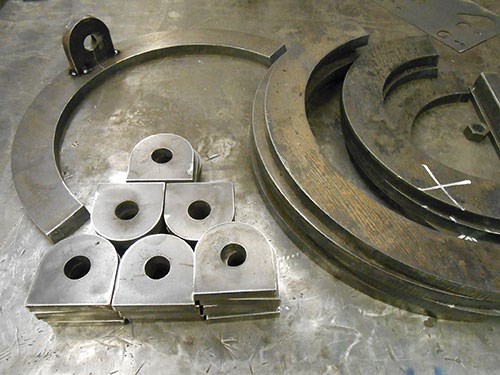Plasma-Cutting System Improves Hole Quality
Purchasing a complete plasma cutting system from Hypertherm enabled Quality Machine to improve cut quality and increase productivity.
Share




When a business relies on being able to design and build custom products, it needs to be able to count on the quality and support of its manufacturing equipment. When one or both of these factors doesn’t live up to expectations, production can come to a complete standstill. Quality Machine in Bridgeport, West Virginia encountered this very problem. Programming inefficiencies and subsequent poor cut quality from its existing plasma cutter hampered the company’s ability to effectively produce its full range of products. By integrating Hypertherm’s plasma-cutting system and software into the manufacturing process, Quality Machine was able to improve cut quality and save both time and money.
The third-generation job shop was founded in 1975 as a service provider for the surface mining industry. It specializes in customized products, such as oilfield units and hydraulic systems for the oil and gas industry. The company has also expanded into a parts business, focusing on large, custom and proprietary jobs producing oil and gas booms, skidded- and trailer-mounted oilfield units, Marcellus Shale fracturing fluid systems, and Hardox extreme-duty buckets.
As a Hardox Wearparts distributor, Quality Machine needs to make high-quality parts at the fastest possible speeds, says Christian Marsh, business manager and safety director. “We have to be able to cut custom-designed parts on the spot. Good plasma cut quality on the holes is especially important because it saves us time and money,” he says. If a hole for a pin or bolt cannot be plasma cut to quality standards, it has to be drilled or punched, which takes more time. To complicate this matter, the Hardox parts are not easily drilled and they cannot be punched due to the material’s high tensile strength.
More production difficulties arose from ineffective integration of plasma equipment components and lack of support from a variety of suppliers. For example, Mr. Marsh says that when there was a problem with the plasma cutter, blame was passed down the line from the OEM, to the software company, to the installers, until the cycle started again. “It was a mess that left us with very little help,” he says. Beyond that, its plasma cutter was supposed to be capable of scribing part numbers and bend lines to ease layout prior to bending on a press brake, but Mr. Marsh says that never worked right.
In search of a way to improve cut quality, the company considered waterjet. However, concerns about operating costs, garnet hassle and higher maintenance costs made the company look for an alternate solution. It began to investigate the recent advancements in plasma cutting and sought help from Hanover, New Hampshire-based cutting machine manufacturer Hypertherm. Quality Machine needed a solution that included efficient nesting software too, because the nesting software on its old plasma cutter was not communicating properly with the unit. In addition, it needed a cutter that could offer precise motion to improve cut quality and overall productivity. The company ultimately adopted Hypertherm’s True Hole technology, which combines a HyPerformance plasma HPR400XD, an EdgePro CNC, ArcGlide torch height control and ProNest 2010 software. By purchasing all of the plasma-cutting components from a single manufacturer, Quality Machine was able to eliminate its previous support issues.
The new plasma system immediately improved hole quality, Mr. Marsh says. The previous unit cut holes that were oblong and tapered. For example, when attempting to cut a 1-inch-diameter hole clearance for a 7/8-inch-diameter bolt, the old machine would cut a 1-inch diameter at the top and a 3/4-inch by 1/2-inch oval at the bottom, thus making the sides of the hole tapered. A 7/8-inch bolt would not be able to fit in that hole, Mr. Marsh says.
True Hole technology is automatically applied by the nesting software package and CNC. A specific combination of parameter settings, such as process gas selection, gas flow rates, pierce and lead-in/lead-out techniques, cut speeds, and cut timing are automatically applied and optimized for mild steel hole quality by specific amperage, material thickness and hole size. For example, after a part model is created in CAD, it is imported into ProNest 2010 where holes are automatically recognized. Machine code is modified to optimize the parameters mentioned above, and all other variables are automatically set to optimize cut quality. One important parameter that is set is the automatic switching from O2/air for the contour cut to O2/O2 for the holes and then back to O2/air to continue finishing the cut. In mild steel applications, True Hole technology can improve cylindricity by as much as 50 percent when compared to common plasma systems, Hypertherm says.
On average, ProNest 2010 has helped Quality Machine increase its productivity by 33 percent, Mr. Marsh explains. The Hardox parts are no longer cut with negative angles and consumables last 30 percent longer. Now, all Hardox parts are cut with the Hypertherm HPR400XD to ensure cut quality. “We wanted everything to work together seamlessly, and the software capability alone is leaps and bounds above what we had before, so our efficiency has improved,” Mr. Marsh says.
Related Content
How to Mitigate Chatter to Boost Machining Rates
There are usually better solutions to chatter than just reducing the feed rate. Through vibration analysis, the chatter problem can be solved, enabling much higher metal removal rates, better quality and longer tool life.
Read MoreQuick-Change Tool Heads Reduce Setup on Swiss-Type Turning Centers
This new quick-change tooling system enables shops to get more production from their Swiss turning centers through reduced tool setup time and matches the performance of a solid tool.
Read MoreInside a CNC-Machined Gothic Monastery in Wyoming
An inside look into the Carmelite Monks of Wyoming, who are combining centuries-old Gothic architectural principles with modern CNC machining to build a monastery in the mountains of Wyoming.
Read MoreLean Approach to Automated Machine Tending Delivers Quicker Paths to Success
Almost any shop can automate at least some of its production, even in low-volume, high-mix applications. The key to getting started is finding the simplest solutions that fit your requirements. It helps to work with an automation partner that understands your needs.
Read MoreRead Next
Registration Now Open for the Precision Machining Technology Show (PMTS) 2025
The precision machining industry’s premier event returns to Cleveland, OH, April 1-3.
Read MoreBuilding Out a Foundation for Student Machinists
Autodesk and Haas have teamed up to produce an introductory course for students that covers the basics of CAD, CAM and CNC while providing them with a portfolio part.
Read MoreSetting Up the Building Blocks for a Digital Factory
Woodward Inc. spent over a year developing an API to connect machines to its digital factory. Caron Engineering’s MiConnect has cut most of this process while also granting the shop greater access to machine information.
Read More






































